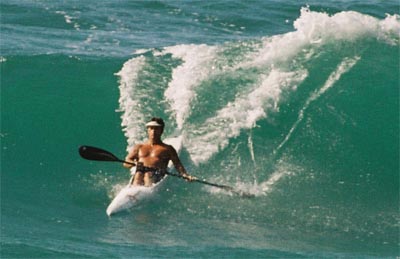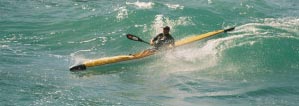First Looks: Knysna Kayaks' Robberg Express
 Towards the end of 2005 a distinctly different ski made its appearance in Hout Bay in the hands of Tom Thring, and it made an immediate positive difference to his race results… Knysna Kayaks, the ski’s manufacturer, is known more for their river craft, but they seem to have scored a hit with this design.
Towards the end of 2005 a distinctly different ski made its appearance in Hout Bay in the hands of Tom Thring, and it made an immediate positive difference to his race results… Knysna Kayaks, the ski’s manufacturer, is known more for their river craft, but they seem to have scored a hit with this design.
It’s been a long time in the making. The design was started in the late 1980’s by the late Daniel Conradie but was shelved when he died. Hubby Sandberg took it on and the final result is the culmination of years of iterative prototyping and testing.
What’s different about it?
“I wanted to achieve a user friendly ski,” said Hubby, “comfortable, but at the same time manoeuvrable and quick on waves. Our design philosophy was to keep the paddler’s body weight as far forward as possible with more volume in the nose.”

Luckily it didn’t turn out as ugly as I thought it would!”
The seat is positioned some 8” further forward than any other ski. The extra volume gives the ski its characteristic bulged nose and its performance going downwind.

The cockpit has a single foot well and the rudder pedals are fully adjustable (although Knysna Kayaks will build you a made-to-measure ski if required). For Hubby the seat is an important part of the design. “Your feet are positioned lower than your bum,” he said, “this is the first ski that I can use for river training.
The back of the seat is cut away “which reduces the chances of hurting your back if you get taken out by a big wave”. Hubby said that they’re aware that the cockpit is very wet; the next version (there is only one mould at present) will see the rails raised by about 50mm.

The photo shows how the ski narrows at the entry point, in front of the cockpit. The pads on either side of the seat were added by Tom Thring. "I put foam on the sides of the seat to prevent my bum sliding from side to side," said Tom, "This makes a huge difference to stability and works better than wax. If you glue something smooth to the foam (I use the top slice of the expanded PE cake which they usually throw away) it doesn't prevent hip rotation".
The hull is flat under the seat – and this, Hubby said, gives the ski its stability. Hubby didn’t use computers for the design which was, he said, inspired in part by nature. “Look at the shape of a dolphin,” he said, “and you’ll see that 2/3 of the volume is to the front of the animal.” Hence the design philosophy to break water as far forward as possible. The shape is similar to that of a tear drop or wing.
“The ski seems to be fast,” said Hubby, “Matt Carlisle has been winning the Masters category up in Durban.”
Knee straps are in development and will be an innovative optional extra. “I’m petrified of coming out on the sea,” said Hubby, “and the straps make it possible to Eskimo roll the ski.” Hubby sees a future where paddlers who can Eskimo roll under big surf will have a huge advantage over those who simply fall off.
User impressions: Tom Thring
“The worst thing about the ski,” says Tom, “is the low freeboard. In any kind of chop, the cockpit fills faster than it drains so you find yourself paddling with about 10kg of unwanted extra weight.” (The next version of the ski will see raised rails being added to the design, see above.)
On the other hand, the cockpit is comfortable. Tom also owns a Fenn Mako Millennium: “The Robberg Express cockpit is much better than the Fenn’s,” he said, “no rubbing near the coccyx and it allows rotation of the hips so my technique is more similar to my K1 technique. This has definitely improved my performance.”
In terms of quality of finish, “The ski hull is better than most skis but not perfect. The hull is well faired and symmetrical, and nicely polished, but there are some wrinkles in the gelcoat near the seams. They appear to have used basic composite materials and processes and (mostly) good craftsmanship.”

Tom confirmed that the ski takes off well downwind. “It responds well to a few hard strokes, to get onto a run for example. My Fenn Mako and the V10s are probably about the same speed but don’t feel as responsive.
I like the bow-down attitude – the bow doesn’t get deflected by wind and chop. It doesn’t purl when on runs at all because of the fat nose.”
The stability is good too: “The stability is better than the Fenn Mako & Millennium – about the same as an Epic V10.”
What doesn’t he like about the ski? Apart from the wet cockpit, Tom wasn’t enthralled with the level of service from Knysna Kayaks. “Delivery was about a month late,” Tom said, “and there were issues with leaks even with standard lay-up (about 17 kg). It was a little unfinished – I had to find my own bit of tube for the air vent. There was no cover on the rudder cavity - they recommended leaving it open, so it can be sorted out at sea if there is a problem. They have promised me one, as well as the foot rest which they left off after fixing a leak…and that was a few weeks ago…”
All in all though, Tom’s happy with the ski. “I’ll be experimenting with some foam to improve the freeboard. I was a little disappointed with service and the ski could be refined in several ways, but other than the freeboard/drainage they have got the basics right.”
Conclusion
It looks as though Knysna Kayaks have added something new to the smorgasbord of new surf skis from which paddlers can choose. The ski is fast and stable enough even for intermediate paddlers and, once the teething problems have been ironed out, it should compete well in the marketplace.

For more information, see: http://www.knysnaracingkayaks.com/

